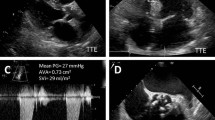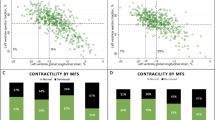Abstract
In patients with significant aortic stenosis (AS), the prognostic effect of the increase in left ventricular mass (LVM) in relation to one’s hemodynamic load has been described. Inappropriately high LVM has been shown to predict adverse cardiovascular events. However, little is known about the prognostic impact of inadequately low LVM (i-lowLVM) in patients with significant AS. I-lowLVM was defined as the measured LVM < 73% of the predicted LVM based on sex, stroke work and height from the reference adult population, used in previous established studies. For outcome analysis, the end-point was defined as all-cause mortality, aortic valve replacement and/or admission for congestive heart failure. Kaplan–Meier curves and multivariable Cox regression models were constructed to compare outcomes on follow-up. During the follow-up (4.5 ± 4.1 years), 132 patients (11.1%) had i-lowLVM, 868 (73.1%) had adequate-LVM, 188 (15.8%) had inappropriately high LVM. Outcome analysis only included patients with i-lowLVM and adequate-LVM (N = 1000). An adverse composite event occurred in 41.7% of the i-lowLVM group and 52.4% of the adequate-LVM group (p = 0.021). Event-free survival in patients with i-lowLVM and appropriate-LVM was 76% versus 68% at 2-year, 55% versus 46% at 4-year, 33% versus 27% at 6-year, 20% versus 17% at 8-year, and 17% versus 11% at 10-year follow-up, respectively (p < 0.001). Cox analysis revealed that i-lowLVM was independently associated with lower composite adverse outcome (HR 0.624, 95% CI 0.460–0.846, p = 0.002) after adjusting for sex, age, ejection fraction, ischemic heart disease, diabetes and transaortic valve mean gradient. In the separate Cox subanalyses, the presence of i-lowLVM remained a predictor of lower composite adverse outcome in the severe AS subgroup (HR 0.587, 95% CI 0.396–0.870, p = 0.008), and the LVH subgroup (HR 0.574, 95% CI 0.401–0.824, p = 0.003) after adjusting for confounders. I-lowLVM despite significant AS may represent a distinct group that is associated with improved survival outcomes independent of other prognostic covariates.




Similar content being viewed by others
References
Cioffi G, Faggiano P, Vizzardi E et al (2011) Prognostic effect of inappropriately high left ventricular mass in asymptomatic severe aortic stenosis. Heart 97:301–307
Aurigemma GP, Silver KH, McLaughlin M et al (1994) Impact of chamber geometry and gender on left ventricular systolic function in patients > 60 years of age with aortic stenosis. Am J Cardiol 74:794–798
de Simone G, Verdecchia P, Pede S et al (2002) Prognosis of inappropriate left ventricular mass in hypertension: the MAVI Study. Hypertension 40:470–476
Kupari M, Turto H, Lommi J (2005) Left ventricular hypertrophy in aortic valve stenosis: preventive or promotive of systolic dysfunction and heart failure? Eur Heart J 26:1790–1796
Palmieri V, Wachtell K, Gerdts E et al (2001) Left ventricular function and hemodynamic features of inappropriate left ventricular hypertrophy in patients with systemic hypertension: the LIFE study. Am Heart J 141(5):784–791
de Simone G, Palmieri V, Koren MJ et al (2001) Prognostic implications of the compensatory nature of left ventricular mass in arterial hypertension. J Hypertens 19:119–125
Baumgartner H, Hung J, Bermejo J et al (2017) Recommendations on the echocardiographic assessment of aortic valve stenosis: a focused update from the European Association of Cardiovascular Imaging and the American Society of Echocardiography. Eur Heart J Cardiovasc Imaging 18:254–275
Lang RM, Badano LP, Mor-Avi V et al (2015) Recommendations for cardiac chamber quantification by echocardiography in adults: an update from the American society of echocardiography and the European association of cardiovascular imaging. Eur Heart J Cardiovasc Imaging 16:233–237
Baumgartner H, Hung J, Bermejo J et al (2009) Echocardiographic assessment of valve stenosis: EAE/ASE recommendations for clinical practice. Eur J Echocardiogr 10:1–25
Teichholz LE, Kreulen T, Herman MV, Gorlin R (1976) Problems in echocardiographic volume determinations: echocardiographic-angiographic correlations in the presence of absence of asynergy. Am J Cardiol 37:7–11
Cioffi G, De Simone G, Cramariuc D, Mureddu GF, Gerdts E (2012) Inappropriately high left-ventricular mass in asymptomatic mild-moderate aortic stenosis. J Hypertens 30:421–428
De Simone G, Devereux RB, Kimball TR et al (1998) Interaction between body size and cardiac workload: influence on left ventricular mass during body growth and adulthood. Hypertension 31:1077–1082
Dlugosz D, Bolt K, Sam WS et al (2018) Excessive left ventricular hypertrophy in moderate degenerative aortic stenosis: an ineffective compensatory mechanism triggered by primary myocardial dysfunction and enhanced by concomitant mild renal impairment? Kardiol Pol 76:1486–1488
Chyrchel B, Długosz D, Bolt K et al (2018) Association of inadequately low left ventricular mass with enhanced myocardial contractility in severe degenerative aortic stenosis. J Clin Med 7:1–7
de Simone G, Roman MJ, Daniels SR, Mureddu G, Kimball TR, Greco R, Devereux RB (1997) Age-related changes in total arterial capacitance from birth to maturity in a normotensive population. Hypertension 29:1213–1217
de Simone G, Pasanisi F, Contaldo F (2001) Link of nonhemodynamic factors to hemodynamic determinants of left ventricular hypertrophy. Hypertension 38:13–18
Chinali M, De Marco M, D’addeo G et al (2007) Excessive increase in left ventricular mass identifies hypertensive subjects with clustered geometric and functional abnormalities. J Hypertens 25:1073–1078
de Simone G, Gottdiener JS, Chinali M et al (2008) Left ventricular mass predicts heart failure not related to previous myocardial infarction: the Cardiovascular Health Study. Eur Heart J 29:741–747
Aurigemma GP, Silver KH, Priest MA, Gaasch WH (1995) Geometric changes allow normal ejection fraction despite depressed myocardial shortening in hypertensive left ventricular hypertrophy. J Am Coll Cardiol 26:195–202
Aurigemma GP, Devereux RB, De Simone G et al (2002) Myocardial function and geometry in hypertensive subjects with low levels of afterload. Am Heart J 143:546–551
2008 focused update incorporated into ACC/AHA (2008) 2006 guidelines for the management of patients with valvular heart disease: a report of the American College of Cardiology/American Heart Association Task Force on Practice Guidelines. J Am Coll Cardiol 52:1–142
Briand M, Dumesnil JG, Kadem L et al (2005) Reduced systemic arterial compliance impacts significantly on left ventricular afterload and function in aortic stenosis: implications for diagnosis and treatment. J Am Coll Cardiol 46:291–298
Pellikka PA, Nishimura RA, Bailey KR et al (1990) The natural history of adults with asymptomatic, hemodynamically significant aortic stenosis. J Am Coll Cardiol 15:1012–1017
Otto CM, Burwash IG, Legget ME et al (1997) Prospective study of asymptomatic valvular aortic stenosis: clinical, echocardiographic, and exercise predictors of outcome. Circulation 95:2241–2243
Devereux RB, Wachtell K, Gerdts E et al (2004) Prognostic significance of left ventricular mass change during treatment of hypertension. JAMA 292:2350–2356
Gošev I, Zeljko M, Đurić Ž, Nikolić I, Gošev M, Ivčević S, Bešić D, Legčević Z, Paić F (2017) Epigenome alterations in aortic valve stenosis and its related left ventricular hypertrophy. Clin Epigenet 9:106
Treibel TA, Fontana M, Gilbertson JA, Castelletti S, White SK, Scully PR, Roberts N, Hutt DF, Rowczenio DM, Whelan CJ, Ashworth MA, Gillmore JD, Hawkins PN, Moon JC (2016) Occult transthyretin cardiac amyloid in severe calci c aortic stenosis: prevalence and prognosis in patients undergoing surgical aortic valve replacement. Circ Cardiovasc Imaging 9:e005066
Cavalcante JL, Rijal S, Abdelkarim I, Althouse AD, Sharbaugh MS, Fridman Y, Soman P, Forman DE, Schindler JT, Gleason TG, Lee JS, Schelbert EB (2017) Cardiac amyloidosis is prevalent in older patients with aortic stenosis and carries worse prognosis. J Cardiovasc Magn Reson 19:98
Nitsche C, Aschauer S, Kammerlander AA et al (2020) Light-chain and transthyretin cardiac amyloidosis in severe aortic stenosis: prevalence, screening possibilities, and outcome. Eur J Heart Fail 22(10):1852–1862
2014 AHA/ACC guideline for the (2014) management of patients with valvular heart disease: a report of the American College of Cardiology/American Heart Association Task Force on Practice Guidelines. J Am Coll Cardiol 63:57–183
Vollema EM, Prihadi EA, Ng ACT, Gegenava T, Ajmone Marsan N, Bax JJ, Delgado V (2020) Prognostic implications of renal dysfunction in patients with aortic stenosis. Am J Cardiol 125(7):1108–1114
Funding
Ching-Hui Sia was supported by the National University of Singapore Yong Loo Lin School of Medicine’s Junior Academic Faculty Scheme.
Author information
Authors and Affiliations
Corresponding author
Ethics declarations
Conflict of interest
The authors declare that they have no conflict of interest.
Ethical approval
This study was conducted in accordance to the revised Declaration of Helsinki and approved by the institutional review committee.
Additional information
Publisher’s note
Springer Nature remains neutral with regard to jurisdictional claims in published maps and institutional affiliations.
Rights and permissions
About this article
Cite this article
Chew, N.W.S., Ngiam, J.N., Tan, B. Q. et al. Inadequately low left ventricular mass in patients with significant aortic stenosis predicts favourable prognostic outcomes. Int J Cardiovasc Imaging 37, 1611–1619 (2021). https://doi.org/10.1007/s10554-020-02146-3
Received:
Accepted:
Published:
Issue Date:
DOI: https://doi.org/10.1007/s10554-020-02146-3




